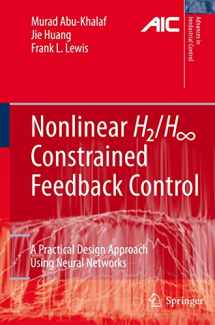
Nonlinear H2/H-Infinity Constrained Feedback Control: A Practical Design Approach Using Neural Networks (Advances in Industrial Control)
ISBN-13:
9781849965842
ISBN-10:
1849965846
Edition:
Softcover reprint of hardcover 1st ed. 2006
Author:
Frank L. Lewis, Murad Abu-Khalaf, Jie Huang
Publication date:
2010
Publisher:
Springer
Format:
Paperback
224 pages
Category:
AI & Machine Learning
,
Robotics
,
Hardware & DIY
,
Automotive
,
Engineering
,
Chemical
,
Mechanical
,
Industrial & Technical
,
Chemistry
,
Computer Science
FREE US shipping
Book details
ISBN-13:
9781849965842
ISBN-10:
1849965846
Edition:
Softcover reprint of hardcover 1st ed. 2006
Author:
Frank L. Lewis, Murad Abu-Khalaf, Jie Huang
Publication date:
2010
Publisher:
Springer
Format:
Paperback
224 pages
Category:
AI & Machine Learning
,
Robotics
,
Hardware & DIY
,
Automotive
,
Engineering
,
Chemical
,
Mechanical
,
Industrial & Technical
,
Chemistry
,
Computer Science
Summary
Nonlinear H2/H-Infinity Constrained Feedback Control: A Practical Design Approach Using Neural Networks (Advances in Industrial Control) (ISBN-13: 9781849965842 and ISBN-10: 1849965846), written by authors
Frank L. Lewis, Murad Abu-Khalaf, Jie Huang, was published by Springer in 2010.
With an overall rating of 3.5 stars, it's a notable title among other
AI & Machine Learning
(Robotics, Hardware & DIY, Automotive, Engineering, Chemical, Mechanical, Industrial & Technical, Chemistry, Computer Science) books. You can easily purchase or rent Nonlinear H2/H-Infinity Constrained Feedback Control: A Practical Design Approach Using Neural Networks (Advances in Industrial Control) (Paperback) from BooksRun,
along with many other new and used
AI & Machine Learning
books
and textbooks.
And, if you're looking to sell your copy, our current buyback offer is $0.3.
Description
This book provides techniques to produce robust, stable and useable solutions to problems of H-infinity and H2 control in high-performance, non-linear systems for the first time. The book is of importance to control designers working in a variety of industrial systems. Case studies are given and the design of nonlinear control systems of the same caliber as those obtained in recent years using linear optimal and bounded-norm designs is explained.


We would LOVE it if you could help us and other readers by reviewing the book
Book review

Congratulations! We have received your book review.
{user}
{createdAt}
by {truncated_author}


